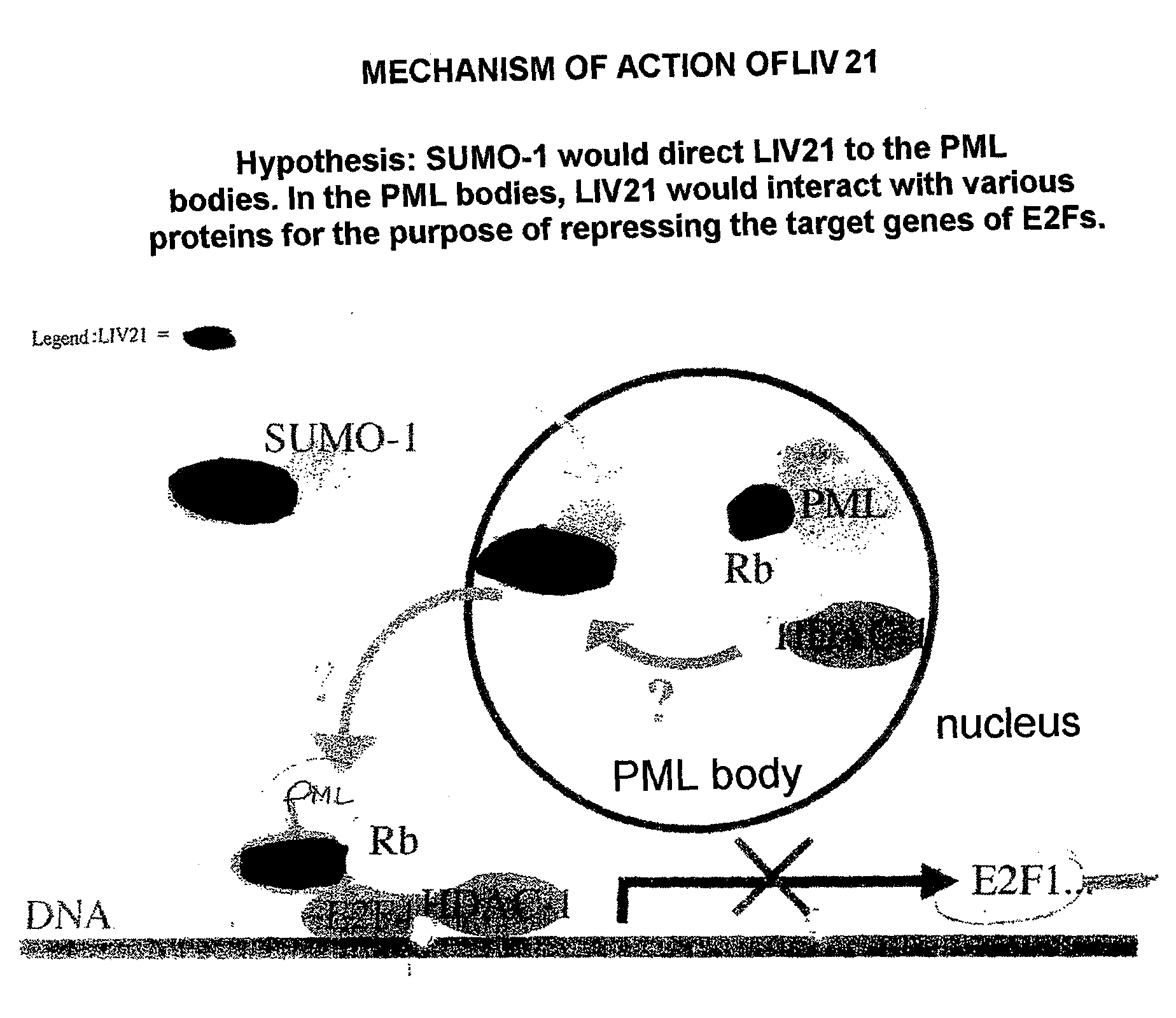Traceability of Cellular Cycle Anomalies Targeting Oncology and Neurodegeneration
a cellular cycle and anomaly technology, applied in the field of medicine and biology, can solve the problems of low survival rate, uncontrolled cell multiplication, and little time for therapeutic intervention
- Summary
- Abstract
- Description
- Claims
- Application Information
AI Technical Summary
Benefits of technology
Problems solved by technology
Method used
Image
Examples
example 1
[0138]The inventor performed mass spectrometry (MALDI) for the LIV21 protein based on a one-dimensional acrylamide gel. The LIV21 protein was digested with trypsin. The peptides derived from the digestion are solubilized in a solvent: acetonitrile / water (1 / 1) containing 0.1% of TFA (trifluoroacetic acid). A saturated solution of the alpha-cyano-4-hydroxycinnamic matrix was prepared in the same solvent. The same volume of the two solutions was taken and mixed together and 1 1.1.1 was deposited onto the MALDI plate for analysis. The mass spectrometry showed that the LIV21 protein digested with trypsin reveals 54 peptides (cf. FIGS. 3-4). The LIV21 protein was characterized by a molecular weight of 50 kD, revealed by Western blotting. Since the first MALDI results were not probative, the inventor produced a two-dimensional SDS PAGE gel (FIG. 8). More than ten proteins were revealed by silver nitrate staining, but the very small amount of material did not make it possible to test sample...
example 2
Study of the Nuclear Translocation of LIV21 in MCF-7 Cells
[0145]The study of the subcellular distribution of LIV21 in different tumor lines of various origins showed an exclusively cytoplasmic localization of this protein. The mechanism(s) by which LIV21 could be translocated into the nucleus in order to act on the cell cycle was (were) shown.
[0146]The presence of putative sites for phosphorylation by protein kinases C (PKCs), based on the possible homology that PATF is thought to have with the LIV21 sequence, directed the inventor's study toward a possible involvement of these proteins with respect to its nuclear translocation. The inventor therefore chose to study the MCF-7 line treated with TPA, which is known to modulate PKCs.
[0147]In parallel to this work, the inventor also studied the expression and the localization of cell cycle proteins implicated in the signaling pathway in which LIV21 could act.
[0148]The MCF-7 Cell Line
[0149]The MCF-7 line is a nonclonal human line of brea...
example 3
Study of the Influence of PKCs on the Nuclear Translocation of LIV21
[0178]Effect of TPA on PKCε Expression
[0179]Western blotting study: Given that the protein sequence of LIV21 has putative PKC phosphorylation sites, including two specific for PKCε, the inventor tested the variation in the expression of this PKC as a function of the duration of TPA treatment. It was observed that TPA acts very rapidly on PKCε expression, which decreases from 30 min (FIG. 18). The expression of PKCzeta (PKCζ) is used as an internal control since it is not sensitive to TPA.
[0180]Immunocytochemistry: In parallel, immunofluorescence experiments on treated or nontreated cultures made it possible to demonstrate this decrease in PKCε concurrent with the nuclear translocation of LIV21 (FIG. 19). It can be observed that PKCε disappears from the cytoplasm when the cells are treated with TPA and that LIV21 is detected in the nucleus.
[0181]To conclude, it is interesting to note that PKCε is weakly expressed at...
PUM
| Property | Measurement | Unit |
|---|---|---|
| size | aaaaa | aaaaa |
| volume | aaaaa | aaaaa |
| molecular mass | aaaaa | aaaaa |
Abstract
Description
Claims
Application Information
 Login to View More
Login to View More - R&D
- Intellectual Property
- Life Sciences
- Materials
- Tech Scout
- Unparalleled Data Quality
- Higher Quality Content
- 60% Fewer Hallucinations
Browse by: Latest US Patents, China's latest patents, Technical Efficacy Thesaurus, Application Domain, Technology Topic, Popular Technical Reports.
© 2025 PatSnap. All rights reserved.Legal|Privacy policy|Modern Slavery Act Transparency Statement|Sitemap|About US| Contact US: help@patsnap.com



